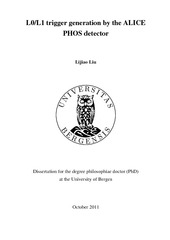| dc.description.abstract | Quark-Gluon Plasma (QGP) is a phase that exists above a critical temperature and corresponding energy density according to the theory of Quantum Chromo-Dynamics (QCD). The studies of the QGP help us to understand the early evolution of our universe and the Standard Model. A large Ion Collider Experiment (ALICE) aims to study the properties of the QGP. A QGP can not be observed directly because it is a short lived state. Signatures such as jet quenching, flow pattern and high pT suppression indicate the existence of a QGP. Various sub-detectors are designed for detecting these signatures. The PHOton Spectrometer (PHOS), one of the sub-detectors, is a high-resolution electromagnetic calorimeter dedicated to the precise measurement of direct photon and neutral meson yields in a pT range up to 100 GeV/c. Four online systems are developed to monitor, control and read out the different subdetectors. The trigger system is one of them. The task of the trigger system is to select events of interest and to reduce the overall data flow in the ALICE experiment. Three levels of triggers and a High Level Trigger (HLT) are designed to make optimal use of different sub-detectors, which vary in readout time. The PHOS detector generates two levels of triggers: i) the Level-0 (L0) trigger selects high pT clusters in Pb+Pb and in p+p collisions; ii) the Level-1 (L1) trigger corresponds to a more sophisticated shower analysis which refines the event selection. The main objective of the thesis has been to develop the PHOS trigger firmware, to implement it in an FPGA and to commission it. The ALICE L0 trigger has a latency of 1.2 μs, limiting the time for generating L0 triggers in the PHOS detector. The algorithms are based on the digitized signal from Avalanche Photo-Diodes (APDs). A sliding-window cluster reconstructor is the critical part. A lot of efforts have been made to fulfill the timing requirement. The ALICE L1 trigger has a latency of 6.5 μs, leaving more time to refine the event selection. There are three types of L1 triggers for PHOS: one basic L1 trigger and two advanced ones: total energy trigger and isolated photon trigger. The firmware development focuses on the L0 generation (chapter 5). The timing analysis (chapter 5), testing and commissioning of the PHOS L0 trigger, which is the main effort during the PhD project as well, have been performed (chapter 7). The generation of L1 triggers is discussed in chapter 6, where the firmware for the basic L1 trigger is implemented. The algorithms and related resource consumption for the advanced L1 triggers are analyzed, but they have not been commissioned yet. Additionally, simulations have been done to analyze how several factors affect the trigger performance (chapter 6). The outline of this thesis is given as follows: After a very brief overview of the physics goal, the sub-detectors and the online systems of the ALICE experiment are described in chapter 1. The PHOS detector is specified thoroughly in chapter 2. Chapter 3 introduces the trigger and readout electronics, based on which the firmware for the triggers (chapter 5) is implemented for the PHOS detector. In chapter 4, the requirements of the ALICE PHOS triggers are given in detail. The principle of issuing triggers is discussed elaborately based on the layout of the detector, irrespective of the trigger electronics. Chapters 5 and 6 discuss the generation of L0 and L1 triggers respectively. Chapter 7 gives the commissioning results. Finally, the conclusion and an outlook are given in chapter 8. The trigger firmware is implemented by two types of electronics boards, Trigger Region Unit (TRU) and Trigger-OR (TOR), I’m responsible for the TOR since 2008. The L0 trigger commissioning has started in Oct. 2008, and it is still ongoing. In addition, I performed the timing analysis, the energy and trigger channel correlation analysis and the L0 trigger performance analysis. Because the L1 algorithm was implemented in the TOR, I analyzed algorithms, resource and timing consumption of all three types L1 triggers, and simulated the L1 trigger performance. | en_US |
